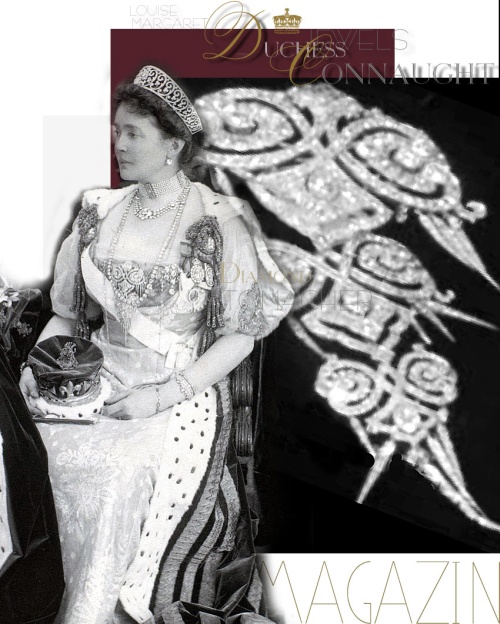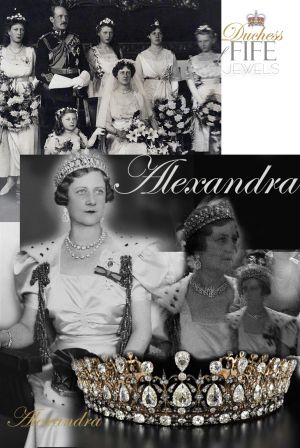
The Duchess of Connaught, the photograph was taken at the Coronation of King George V 1911, 1865-1936.
Queen Victoria of Great Britain and Ireland, Queen Victoria’s tiara, Queen Victoria’s brooch, Queen Victoria’s wedding gift, Queen Victoria’s bracelet, Queen Victoria’s diadem, Queen Victoria’s tiaras, Queen Victoria’s royal jewels, Queen Victoria’s ruby and diamonds, Queen Victoria’s diamond, Queen Victoria’s necklace,Queen Victoria’s parure, Queen Victoria’s opals, Queen Victoria’s sapphires, Queen Victoria’s turquoises, Queen Victoria’s pearls, Queen Victoria coronet,

The Duchess of Connaught, the photograph was taken at the Coronation of King George V 1911, 1865-1936.

From Queen Victoria to the Queen Consort Camilla in 2023



Queen Victoria’s Hesse Diamond Jubilee Brooch|Queen Consort Camilla>>

Four of Princess Alice’s surviving children and their spouses gave their grandmother a magnificent diamond and sapphire brooch.
The Emperor and Empress of Russia, the Grand Duke and Duchess of Hesse, the Grand Duchess Elizabeth Feodorovna “Ella” and the Grand Duke Serge along with Princess Victoria and Prince Louis of Battenberg’s gift was “…a brooch with an open pendant heart of diamonds, bearing in the centre the number „60“ in Slavonic characters. It has on the top a cabochon sapphire and there are two large sapphire drops.” The jewel was made in the workshops of Fabergé(the see note from Empress Alexandra about the payment) more >>>

The Queen’s Jewellery Victoria’s bow brooches

The Exquisite Pearl and Enamel Musical Domino Box by BautteIs one of the most exquisite examples of early 19th-century Geneva workmanship Dominoes was said to be one of Queen Victoria and Prince Albert’s favourite pastimes |

| Eine rechteckige, mit blauer Emaille und Perlen besetzte Dominobox, die einst Königin Victoria gehörte, wird am 5. Juli bei Sotheby’s in London im Rahmen der kommenden Auktion Treasures versteigert. Das Set, eines der exquisitesten Beispiele Genfer Handwerkskunst aus dem frühen neunzehnten Jahrhundert, ist auf 250.000 und 400.000 Pfund geschätzt. Das Dominospiel soll eine der Lieblingsbeschäftigungen von Königin Victoria gewesen sein, die das Spiel zwischen 1839 und 1861 fast 40 Mal in ihrem Tagebuch erwähnte. Die Königin, die von 1837 bis 1901 regierte, spielte besonders gerne Domino mit ihrem Mann Prinz Albert. In einem Eintrag vom Sonntag, dem 18. Dezember 1842, den sie auf Schloss Windsor verbrachte, schreibt sie: „Albert las mir vor, und wir spielten Dominos, ein so gutes Spiel.“ Nach seinem Tod im Jahr 1861 wurde das Dominospiel jedoch nicht mehr erwähnt; es wird behauptet, dass sie das jetzige Set ihrem jüngsten Sohn, Prinz Leopold, Herzog von Albanien, schenkte, der ein Liebhaber von Spielen war und das Londoner Schachturnier 1883 unter seiner Schirmherrschaft veranstaltete. Die Nachkommen von Prinz Leopold vererbten das Set, bis es vor fast 40 Jahren bei einer Auktion von den heutigen Besitzern erworben wurde. Das zwischen 1804 und 1808 von Jean-François Bautte (1772-1837) in Genf geschaffene massive Goldgehäuse mit durchscheinend blauer Emaille ist ein unglaublich seltenes Liebhaberstück, von dem bisher nur ein weiteres Exemplar bekannt ist. |

| Queen Victoria’s Domino Set A rectangular blue enamel and pearl encrusted domino box once belonging to Queen Victoria is set to come to auction on July 5th at Sotheby’s London as part of the upcoming Treasures sale. One of the most exquisite examples of Geneva workmanship from the early nineteenth century, the set is estimated to fetch between £250,000-400,000. Playing dominoes was said to be one of Queen Victoria’s favourite pastimes, with the game mentioned nearly 40 times in her journal between 1839 and 1861. The Queen, who ruled between 1837 and 1901, particularly loved to play the game with her husband Prince Albert. In one entry from Sunday December 18th 1842, which was spent at Windsor Castle, she writes: “Albert read to me, and we played at dominos, such a good game.” However, after his death in 1861, reference to the game ceased to be recorded and it is purported that she gave the present musical domino set to her youngest son, Prince Leopold, Duke of Albany who was a lover of games and held the 1883 London Chess Tournament under his patronage. The set was passed down through the descendants of Prince Leopold until it appeared at auction nearly 40 years ago when acquired by the current owners. Created in Geneva between 1804-1808 by Jean-François Bautte (1772-1837) the solid gold case overlaid with translucent blue enamel is an incredibly rare amusement piece, with only one other example recorded so far. Bautte – the most renowned jeweler in the city in the late eighteenth and early nineteenth century was part of the so called Geneva Fabrique which was a tightly knit community of merchants, watchmakers, casemakers and goldsmiths was one of the largest employers in Geneva at the end of the 18th century. Well known to the experienced eye in Paris and London, Bautte’s work caught the attention of Queen Victoria partially thanks to the famous art critic and Victorian polymath John Ruskin (1819-1900), who published his report on Bautte the year after she became Queen. The charming domino set with its playful decoration is relatively small in size. A matching oval pearl-set gold and enamel key winds the musical movement revealed by the sliding lid. Matching their container, the 28 counters are enameled in translucent blue with their numbers formed of split-pearls. The silk-lined velvet case also features a paper label with the Saxe-Coburg-Gotha coat of arms on the underside. The sides of the enamel box have four vignettes representing the four seasons: picking flowers for the spring, wine drinking in the summer, the harvest in the autumn and ice skating in winter. The lid of the box is enamelled with a sailing Cupid on his quiver. The game of Dominoes arrived in Europe in the early 18th century, probably first brought back by Italian missionaries returning from the Far East who are said to have adapted the Chinese version by adding an additional seven dominoes. Furthermore, during the 1780s, the industrious Swiss watch and enamel industry created marvelous pocket watches and objects of vertu for the extremely lucrative Chinese Market, as well as for export to the Ottoman market. It was towards the end of the 18th century that the game of dominoes reached Britain. |





above the sketch of the wedding gift the “parure” of opals and diamonds from both her parents


Royal Jewels with Opals |Princess Louise of Great Britain & Irland | Duchess of Argyll

On 2 March 1879 Queen Victoria recorded in her journal that she had told her son, Arthur, Duke of Connaught, she would give his wife to be, an Indian diadem.
Then on 12 March 1879 Queen Victoria described showing her gifts to the bride and others, again referring to an Indian diadem.
The Duchess was pictured, with the royal tiara, only one time in 1893, see above, and give it later to her daughter Princess Patricia of Connaught.
In 1911, the Duke was appointed Governor General of Canada. Princess Patricia accompanied her parents to Canada, and she became popular there, on those occasion she wore her mothers wedding gift, the Indian diamond tiara as stomacher, without the center, of a movable ornament like a sarpech on top, with hanging emerald drop.
Sarpech, also known as an aigrette is a turban ornament that was worn by significant Hindu and Muslim princes.

She had her own jewels and tiaras for royal events, because , her mother’s precarious health meant the unmarried Patricia often step in for her mother, as vice-regal hostess, especially during the Duke of Connaught’s tenure as Canada’s governor general from 1911 to 1916.
click for more history :
Mit dem „Accient in Lieu“ -System können Briten – Steuerpflichtige wichtige Kunstwerke und andere Kulturgüter in öffentliches Eigentum überführen, während sie die Erbschaftssteuer oder eine ihrer früheren Formen zahlen. Der Steuerpflichtige erhält den vollen offenen Marktwert des Gegenstands, der dann einem öffentlichen Museum, Archiv oder einer Bibliothek zugewiesen wird. Dies wurde nun von dem Arts Council England für die Fife Tiara akzeptiert!
Die Geschichte dieses Diadem von Oscar Massin ist hier zu finden:
Prinzessin Louise von Wales Hochzeitsgeschenke
Princess Royal Louise Duchess of Fife | Massin Diamond Tiara
Prinzessin Royal Louise Herzogin von Fife | Royal Wedding gifts
Prinzessin Royal Louise Herzogin von Fife | Marriage presents|Schmuck Hochzeitsgeschenke
Princess Royal Louise Duchess of Fife | Jewels, Diamond Comb
Princess Royal Louise Duchess of Fife | Forget-me-nots jewels
Princess Royal Louise of England | Arrow Diamond Brooch |Gifts and Presents
The Acceptance in Lieu scheme enables taxpayers to transfer important works of art and other heritage objects into public ownership while paying Inheritance Tax or one of its earlier forms. The taxpayer is given the full open market value of the item which is then allocated to a public museum, archive or library.

ssion of her daughter:
Alexandra Duchess of Fife | Diamond Jewels Fringe Tiara | Princess Arthur of Connaught
Royal Wedding Jewels Diamond Tiara | Alexandra Duchess of Fife | Princess Arthur of Connaught
Alexandra Duchess of Fife| Aigrette Royal Wedding Jewels | Diamond Bracelet Bandeau Collar Necklace